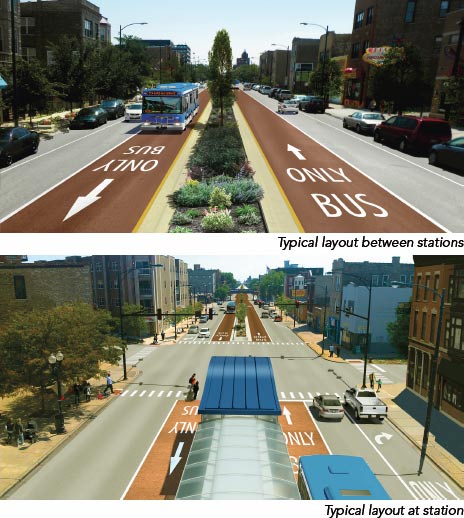Chicago planners push boldest bus-rapid-transit option
By Chip Mitchell

Chicago planners push boldest bus-rapid-transit option
By Chip Mitchell
Now the bus-rapid-transit plan must survive political vetting by Mayor Rahm Emanuel’s office. Emanuel, a professed BRT supporter, could face a storm of criticism from business owners and motorists who want no part in one of the country’s most ambitious bus projects. The mayor’s office could order the preservation of all existing Ashland traffic lanes and kill plans to run the buses in lanes along the avenue’s center — a feature vital for trimming travel times.
Officials say the design backed by the city’s planners would transform at least 4.5 miles of Ashland, stretching from the “Ashland” station of the Chicago Transit Authority’s Orange Line to the “Division” station of the CTA’s Blue Line. That route would extend further north and south when, if ever, the city secured funding. A proposal for BRT along nearby Western Avenue would go on the back burner.
The Ashland plan has the backing of planning and policy directors in the CTA, the Chicago Department of Transportation and the Chicago Department of Housing and Economic Development, according to the officials, who spoke on condition of anonymity because they weren’t authorized to discuss the matter publicly.
Some Chicago business owners along the route are already voicing worries about BRT, particularly about eliminating non-bus lanes. “The idea of cutting the traffic capacity in half has caused a lot of questions for businesses and property owners,” said Roger Romanelli, executive director of the Randolph/Fulton Market Association.
City officials respond that their BRT plan would slow automobiles just slightly and speed up buses dramatically. The city says the new bus service would be up to 80 percent faster than today’s service.
Other questions concern the left turns. Romanelli said business owners are wondering how limiting them “would economically impact businesses, truck deliveries, residents moving east-west, coming from shopping.”
City officials say they must remove some left turns to keep the buses moving fast and protect pedestrians.
Asked whether Emanuel was behind the plan and whether he would stick behind it if business owners revolted, his office had little to say. “All of this is still under review,” Tom Alexander, a mayoral spokesman, wrote in an email message to WBEZ.
In November, Romanelli’s group helped form the Ashland Avenue-Western Avenue Coalition to give some area businesses a greater voice in the BRT planning. The coalition’s other members include the Near West Side Community Development Corporation, the Near West Side Chamber of Commerce, the West Town Chamber of Commerce, and a business group called the West Central Association.
Last week coalition members met with city officials and area aldermen about the project. The officials said the city had made no final decision on the design.
The design favored by the Chicago planners resembles the boldest of four BRT alternatives the city presented last fall for the corridor. Each direction of Ashland would have one regular traffic lane and, near the middle of the avenue, a bus-only lane.
In each direction, the design leaves a parking lane next to the sidewalk, city officials say. There would be no bike lanes.
Several features would distinguish the project from a new express line along the South Side’s Jeffery Boulevard that began in November. Ashland’s inside lanes would be dedicated to the buses around-the-clock, not just during rush hours. For quick boarding, the route would include station platforms and extra-wide bus doors. Those doors would be on the left side of the buses. Passengers would pay before boarding or the city would find fare-card readers that would be almost as quick.
Like the Jeffery line, the Ashland route would include traffic lights rigged to favor the buses and station enhancements such as bike racks and electronic bus-tracking signs. Like the Jeffery bus stops, the Ashland stations would be limited to roughly every half mile.
The Ashland route would include a landscaped median, according to a city staffer familiar with the plan. The CTA said last fall it had decided against narrowing the avenue’s sidewalks.
The CTA’s No. 9 bus, which runs on Ashland Avenue, in 2011 had 10 million boardings, the second most of any Chicago route that year, according to a city web page.
An advantage of building BRT on Ashland instead of Western, city officials say, is closer proximity to the Illinois Medical District, which includes Rush University Medical Center, the University of Illinois Medical Center, the Jesse Brown VA Medical Center, and Cook County’s John H. Stroger Jr. Hospital.
The city has studied the Ashland and Western options using a $1.6 million grant from the Federal Transit Administration, part of the U.S. Department of Transportation. The city has not arranged construction funding.
A much shorter BRT line is scheduled for construction next year. That route will cross Chicago’s Loop and include a new bus terminal at Union Station, a train depot. The project’s funding includes $24.6 million from the FTA and $7.3 million in city tax increment financing.